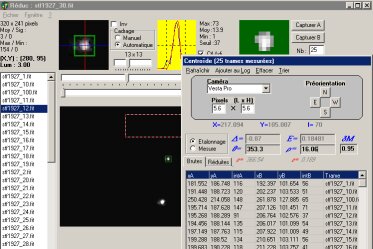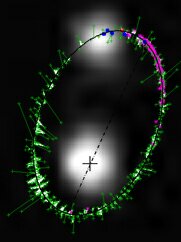Imaging
|
1° calibration star STF 1927 
 ......
......

STF 1864 
 ......
......

STF 1879 
 ......
......

STF 1884 
 ......
......

etc ... Pictures taken with the 8" at 6m25 focal distance. |
First of all we capture a calibration star (rom the calibration list
published by the french Commission des étoiles doubles or from
the WDS calibration list) Then we capture the stars at the program of the night ... The session finally ends by a new calibration star. This second calibration star permits to confirm among other things that there was not accidental change of the position of the camera. New advantage of the webcam in relation to the other systems : its speed. We can capture as many frames as we wish. 100 to 150 pictures are sufficient to get a lot of measurable frames. A well led session permits to capture from 6 to 10 stars/hour We don't need no more to spend a whole night outside to acquire only some measurements ! |
Reductions
Well, we have our images, it's now necessary to transform all that material in good old astrometric values !From the calibration stars we deduct the
calibration constants,
that is to say the exact orientation of the picture in relation to
the sky
as well as its scale (the sampling)
Calibration Stars

353°3 - 16 ''06
Shift of the picture in angle = +0°92
Sampling = = 0''18498/pixel
It is now time to measure the pictures acquired during the evening
Here are the values measured for our short session
STF 1864  110°57 - 5''55
110°57 - 5''55
STF 1879  085°88 - 1''55
085°88 - 1''55
STF 1884  055°59 - 2''11
055°59 - 2''11
etc ...
|
Astronomical softwares possess functions
calculating the stars photocenters.
|
What does that give?
A same couple will be observed two or three times at close epochs.The average of these observations will provide the final measurement.
|
|
|
A few other results obtained with the same instrumentation. |
So no more micrometers?
No, no don't think that!
There are many things that the webcam cannot do,,
first of all you
need a computer.
Then the webcams remains limited to the couples with a small
magnitude difference.
After several hundreds visits of double stars, all used webcams
shows severe limitations as soon as the difference of magnitude passes
beyond 2,5 to 3 mag.
The micrometer is equally better with tight stars.
On the other hand, as soon as the separation reaches about the
double of the resolution power,
I bet that the measures are systematically at least as good as
those obtained with the micrometer (on a same instrument of
course!)
Ok, ok, what are the options ?
|
Webcams in commercial version,
that is to say without electronic modification can reach the 9th
mag at F15. |
My
webcam is commercially suited without modification, could I do some
valuable work either ?
Under our latitudes, there is about 1500 couples with a magnitude difference
< 2 and with the separation accessible to an 8" telescope.
At a rate of 100 stars per year, that makes a fifteen years
program !!!
Surely sufficient to absorb the 50$ insvestment !
Conclusion
in spite of some limitations the webcam
proves very pleasant to use.
Its major advantages are:
- simplicity of use
- impersonal instrument
- speed allowing many observations in one night
- comfortable reductions with the help of
computer software
- precise measurent with an unbeatable
quality/cost ratio
Double Stars are waiting for
you!!!
 Most of the time the pictures are not stacked but measured one by
one and the final measurement is the average of every individual measurement.
Most of the time the pictures are not stacked but measured one by
one and the final measurement is the average of every individual measurement. STF1785 is an orbital binary.
That is to say that the two stars evolve around the same center of mass.
This system is followed regularly since its discovery. We saw it browsing
a complete orbit.
STF1785 is an orbital binary.
That is to say that the two stars evolve around the same center of mass.
This system is followed regularly since its discovery. We saw it browsing
a complete orbit.